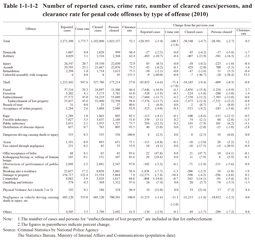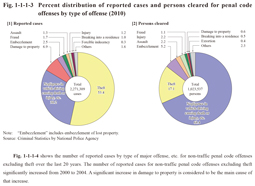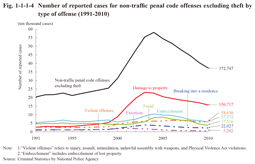1 Reported cases and crime rate
The number of reported cases for penal code offenses reached a new post World War II (WWII) high level every year from 1996, peaking at 3,693,928 cases in 2002. However, the number was decreasing from 2003, and was 2,271,309 in 2010 (down 128,393 or 5.4% from the previous year). The main cause of the recent decrease in the number of reported cases is that the number of reported cases of theft, which typically accounts for approximately 60% of all penal code offenses every year, was decreasing from 2003 (See Subsection 1, Section 2). The number of reported cases for non-traffic penal code offenses excluding theft was increasing until 2004, but then consistently decreased every year from 2005 through to 2010. The number of reported cases for penal code offenses was decreasing in recent years, but examining the number of reported cases from post WWII indicates that the number remained at a considerably high level.
The crime rate for penal code offenses was basically on the same trend as the number of reported cases. The crime rate reached a new post WWII high level every year from 1998 (at 2,127.2), peaking at 2,897.5 in 2002. It then started to decline from 2003, and was 1,773.7 in 2010 (down 108.3 points from the previous year) (See Appendix 1-1).
Table 1-1-1-2shows the number of reported cases for penal code offenses and the crime rate by type of offense in 2010 and Fig. 1-1-1-3 [1] the percent distribution of reported cases by type of offense. Examining the data by type of offense revealed that the percentage was the highest for theft at 53.4%, followed by negligence in vehicle driving causing death or injury, etc. (30.2%), damage to property (6.9%), embezzlement (including embezzlement of lost property; hereinafter the same in this section) (2.5%), and fraud (1.7%).
Table 1-1-1-2 Number of reported cases, crime rate, number of cleared cases/persons, and clearance rate for penal code offenses by type of offense (2010)
Fig. 1-1-1-3 Percent distribution of reported cases and persons cleared for penal code offenses by type of offense (2010)
Fig. 1-1-1-4 shows the number of reported cases by type of major offense, etc. for non-traffic penal code offenses excluding theft over the last 20 years. The number of reported cases for non-traffic penal code offenses excluding theft significantly increased from 2000 to 2004. A significant increase in damage to property is considered to be the main cause of that increase.
Fig. 1-1-1-4 Number of reported cases for non-traffic penal code offenses excluding theft by type of offense (1991-2010)


